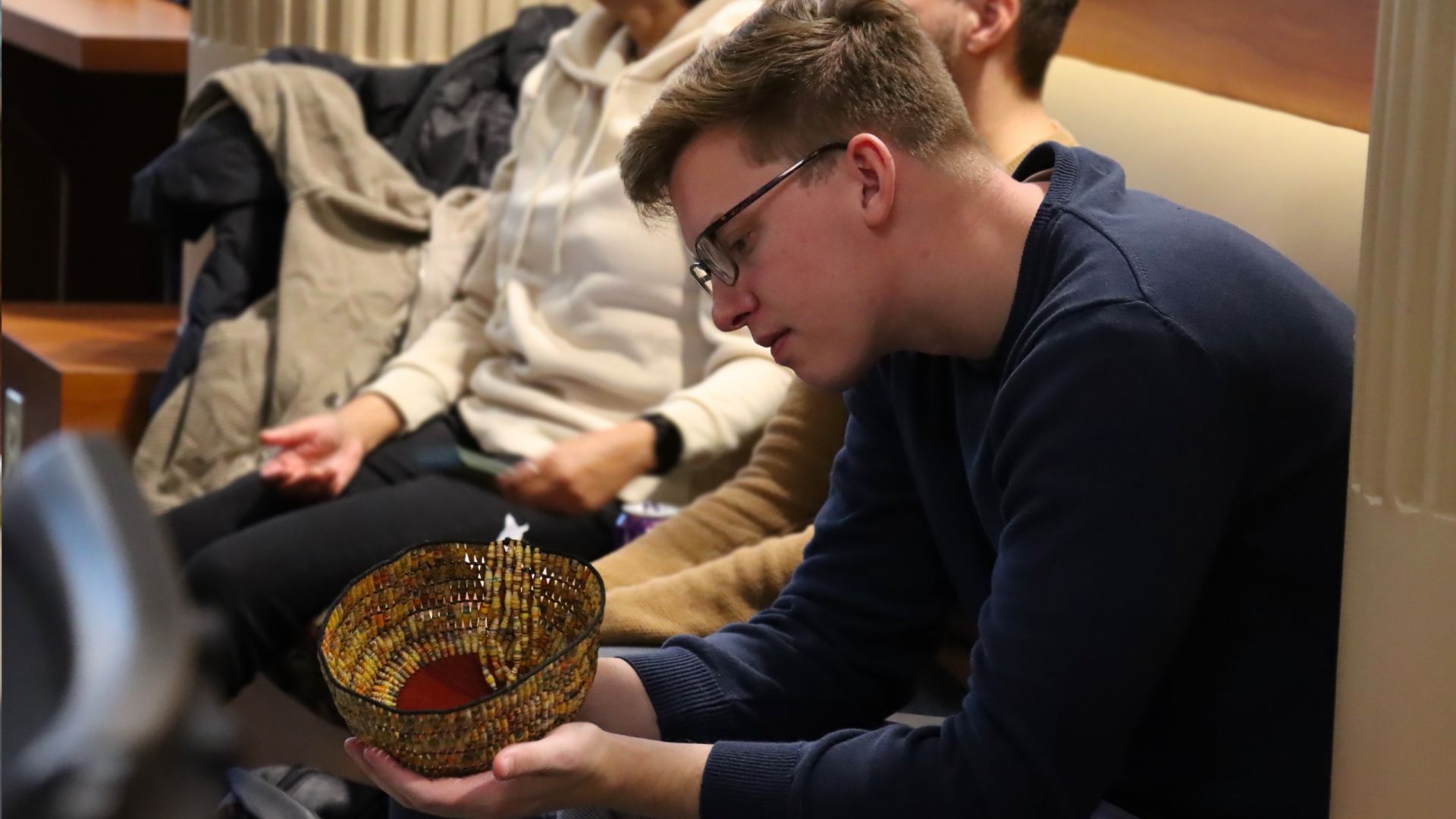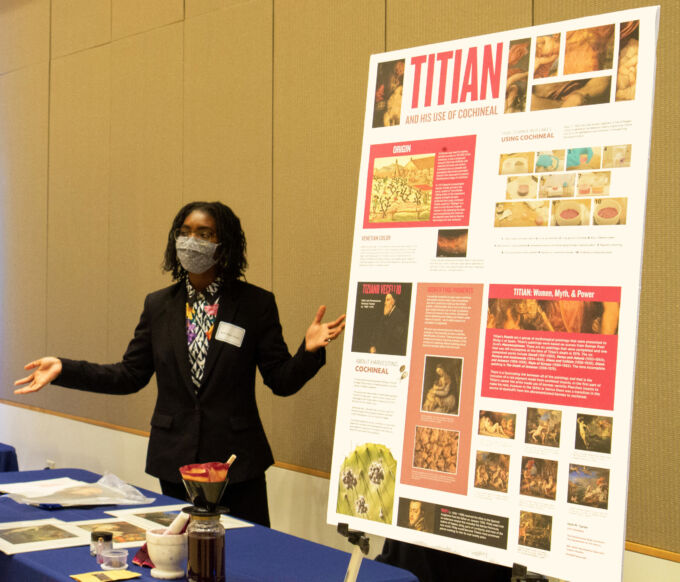
Art History, Ph.D.
Ph.D. in Art History (+Dual Ph.D.)
Become a professional in the field! Advance your career with an advanced degree.
Advanced study of visual arts spanning periods, cultures, and geographies. The Art History Ph.D. program can deepen your expertise and advance your Art History career.
Program Application Deadline
Annual application deadline is January 15.
To be assured full consideration, please review all details on program and admission requirements, and ensure that you apply by this deadline.
Earn a Ph.D. in Art History at Penn State
Our Ph.D. students and alumni have earned Fulbright and Getty Fellowships, the Rome prize, tenure-track positions, and curatorial fellowships and jobs. For more than fifty years, our graduates have been writing books, organizing exhibitions, teaching college and pre-collegiate students, and ensuring the preservation and understanding of our cultural heritage. Join us!
The Ph.D. in Art History program will prepare you to broadly influence art and culture through careers as scholars and educators, as museum curators, as public advocates of cultural heritage, and as arts administrators, to name just a few of the professions that recent program alumni have entered. Breadth of knowledge is as essential for museum professionals as it is for academic researchers. For this reason, advanced study of the visual arts and material culture from diverse periods and geographies is required of all graduate students, with Ph.D. candidates attaining deep expertise in at least one field of art historical research. The department’s faculty includes specialists in African, Asian, and European art and the arts of the Americas.
Graduate faculty members and advisors are leading scholars in their fields. Our interdisciplinary program challenges you to think critically and creatively in order to make a meaningful contribution to the field. The Ph.D. in Art History program also offers dual-title Ph.D. options in Asian Studies or Visual Studies.
Next Steps
Is the Ph.D. in Art History right for you?
A Ph.D. makes possible the highest level of career success in art history. Our program has a track record of excellent outcomes in diverse career paths, with particular success in placing students in academic and museum careers.
We help you ask and answer the big questions in your area of study. Our graduate students have opportunities to teach, research, and work on digital humanities projects with our Center for Virtual and Material Studies. The Palmer Museum of Art also provides internships to prepare you for curatorial work.
Engage with a dynamic cohort of fellow students and a supportive community of scholars.
Degree Options
Dual-title degree options add a significant interdisciplinary breadth to your Ph.D. scholarship. These two dual-title programs develop context through which you can learn to synthesize knowledge within and across disciplinary boundaries in both scholarship and teaching.
Dual Ph.D. and Asian Studies
The primary objective of the dual-title degree program in Asian Studies is to engage critically and substantively with the teaching, research, and scholarship of Asia, a diverse area with a population of some 4.5 billion. The program integrates knowledge and methodology across disciplines of Asian Studies and Art History.
Graduate students are trained in such a way that you will be equipped to represent, understand, analyze, and appraise the crucial and current scholarly issues in Asian Studies in the context of your art discipline focus.
The program aims to produce doctoral graduates with a competitive advantage for employment that relates to Asia in academia, museum, curatorial, and other professional fields.
Graduate Bulletin Links
- Asian Studies Bulletin page
- Graduate Studies information related to the dual-title Ph.D in Art History + Asian Studies.
Dual Ph.D. and Visual Studies
Humanistic study. Technological dynamics. Analyze images, physical and virtual environments, and visual sign systems; histories of visual modes of communication, apprehension, and aesthetic pleasure; and conceptions of the nature of visuality itself. Challenge boundaries. Challenge yourself.
The dual-title Ph.D. in Visual Studies fosters an interdisciplinary approach to humanistic study, which, spurred by technological dynamics that increasingly integrate text and image, engages analysis of specific images, physical and virtual environments, and visual sign systems; histories of visual modes of communication, apprehension, and aesthetic pleasure; and conceptions of the nature of visuality itself. Students in this program analyze and assess visual media that, integrated with texts, are integral to humanistic scholarship and pedagogy today.
Dual-title degree programs increase the intellectual rigor and breadth of graduate work and provide a context in which students learn to synthesize knowledge within and across disciplinary boundaries in both scholarship and teaching. Drawing from knowledge and practices produced across the humanistic disciplines while responding to ongoing challenges to conventional disciplinary boundaries, this degree highlights existing strengths of graduate training in the humanities at Penn State, structures the continuing development of these programs, and credentials our graduates’ training and work with visual forms, environments, and media.
Graduate Bulletin Links
Level Up
Professional Development
Our department is regularly invited to select graduate students to participate in major graduate student symposia, including the Middle Atlantic Symposium in the History of Art at the National Gallery of Art in Washington, D.C., and the Barnes Foundation Graduate Student Symposium on the History of Art. Penn State art history graduate students often present papers at scholarly conferences/symposia across the United States and abroad (for which the department provides partial financial support).
Financial Support
- George Dewey and Mary J. Krumrine Endowment
This endowment helps support publication projects of art history faculty and graduate students. - Graduate Assistantships
There are about nineteen graduate assistantships filled by graduate students in the Department of Art History each year. - University Fellowships and Awards
Qualified incoming graduate students may also be nominated by the department for University Fellowships, Bunton-Waller Graduate Awards, Graham Fellowships, and other awards. The department also has funds to help support graduate students in their research and travel related to their theses. The department awards dissertation fellowships and travel/research grants totaling over $60,000 to graduate students each academic year.
Summer Opportunities
- Summer Abroad program in Todi, Italy
The Department of Art History is a co-sponsor of Penn State’s Summer Abroad program in Todi, Italy, in which graduate students may choose to participate. - Annie Gooding Sykes Internship
This internship is a twelve-week internship offered during the summer. Interns work with museum staff on a variety of curatorial projects, with a particular focus on American works on paper. Students who have completed the ARTH 409 “Museum Studies” course are preferred. One internship with a stipend is offered each summer. - Silver Trout Curatorial Graduate Internship Program
This internship program is a twelve-week internship offered during the summer. Interns work with the museum staff on curatorial projects and initiatives. Graduate students in art history or art education are eligible for the Silver Trout Curatorial Graduate Internship Program. Students who have completed the ARTH 409 “Museum Studies” course are preferred. Two internships with a stipend are offered each summer.
Ph.D. Students
Students currently enrolled in the Ph.D. in Art History programs.
Guides and Resources

Alumni Success
95 percent of those who earned their Ph.D. since the year 2000 are employed in art history or a related field.
- Of these, 71 percent are teaching at the college level.
- The other 29 percent hold such positions as museum curator or lead historian at a historic center.
- Of those teaching at the college level, 67 percent hold tenure-track or tenured positions.


